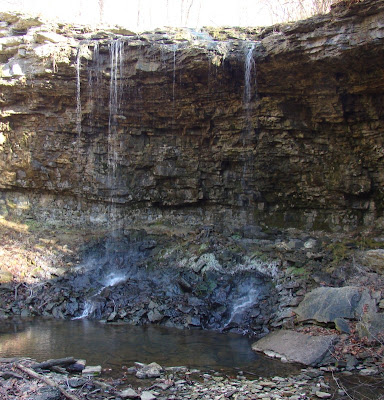In case you haven't noticed, Ohio is full of trees, or at least it was. Historically vast portions of Ohio were wooded and big- very big trees- were the norm. Now it is a big deal to see an ancient tree. In fact "old growth" forests like
Dysart Woods and
Johnson Woods are cherished relics from our past.
Ashland County has a few goodies in the tree department as well.
A complete data base of Ohio's Big Tree program is available on the Ohio Division of Forestry's website. As a young forester, Brian Riley traveled throughout our state updating this information a few years ago. If you are interested in seeing some of these beautiful trees that have withstood the test of time, the information on species and location is readily available- just click on the Big Tree link above.
 Photo by Su Snyder
Photo by Su Snyder
Gary Cowell, Jr. hugs Ohio's second largest Green Ash tree on a recent Greater Mohican Audubon Society Bird Walk at Byers Woods. Check out our GMAS website for the walk schedules, and you will find we look at more than just birds. Join us on a trip to Secrest Arboretum (home of Ohio's Giant Dogwood, Cornus controversa) or our annual spring visit to Fowler Woods (home of Ohio's largest Black Ash, Fraxinus nigra.)
For more fun, click on the GMAS Facebook link in the sidebar of this page, and become a "fan" of GMAS. You'll also find a fun photo of the group gathered at the base of this Green Ash at Byers Woods.
Buy a gift membership for a friend and soon you'll be saying, "GMAS is good birding and a whole lot more!"
 Poision Ivy, Toxicodendron radicans produces white berries that are favored by the birds. This particular vine had been hosting Eastern Bluebirds, this Red-bellied Woodpecker and a delightful Pine Warbler!
Poision Ivy, Toxicodendron radicans produces white berries that are favored by the birds. This particular vine had been hosting Eastern Bluebirds, this Red-bellied Woodpecker and a delightful Pine Warbler! But remember- people should avoid white berries! Another member of the itch-inducing, Anacardiaceae family- Poison Sumac, Toxicodendron vernix berries festooned the perimeter of this portion of our CBC territory. If you find the much rarer Poison Sumac, you'll know with certainty you are in or near a bog or fen.
But remember- people should avoid white berries! Another member of the itch-inducing, Anacardiaceae family- Poison Sumac, Toxicodendron vernix berries festooned the perimeter of this portion of our CBC territory. If you find the much rarer Poison Sumac, you'll know with certainty you are in or near a bog or fen. And indeed, Ryan Steiner was scaning for sparrows near the entrance to Brown's Lake Bog, a TNC property that hosts the rarest and most unusual native plants found in Wayne County.
And indeed, Ryan Steiner was scaning for sparrows near the entrance to Brown's Lake Bog, a TNC property that hosts the rarest and most unusual native plants found in Wayne County.  The Pitcher-plant, Sarracenia purpurea is well adapted to capture nutrients unavailable in the acidic soil. These little cauldrons of death will neatly drown and dissolve any insects misfortunate enough to venture in. However, the layer of ice within these "pitchers" would prevent winter feedings, even if if there were any insects available.
The Pitcher-plant, Sarracenia purpurea is well adapted to capture nutrients unavailable in the acidic soil. These little cauldrons of death will neatly drown and dissolve any insects misfortunate enough to venture in. However, the layer of ice within these "pitchers" would prevent winter feedings, even if if there were any insects available. And one for the reptile lovers: Jeff Spaudling does a visual necropsy on an unfortunate garter snake, who looked to be the victim of some violent death. Several puncture injuries consistent with claws or teeth were found along its body. Jeff is our CSI of the CBC! But unlike the CSI, we left the body for the winter birds. Raptors have to eat too, you know!
And one for the reptile lovers: Jeff Spaudling does a visual necropsy on an unfortunate garter snake, who looked to be the victim of some violent death. Several puncture injuries consistent with claws or teeth were found along its body. Jeff is our CSI of the CBC! But unlike the CSI, we left the body for the winter birds. Raptors have to eat too, you know!



 One of the doves in Celina was considerably lighter in color (rear left) than the others, and Alvaro wrote of possible variants of this species or the interbreeding with Ringed Turtle-Doves. Ringed Turtle-Doves are the domestic dove breed most commonly used by magicians. Maybe someone near Celina can get a few better shots than these sorry, damp doves cowering in the wind, and we could have a closer look at this mystery dove.
One of the doves in Celina was considerably lighter in color (rear left) than the others, and Alvaro wrote of possible variants of this species or the interbreeding with Ringed Turtle-Doves. Ringed Turtle-Doves are the domestic dove breed most commonly used by magicians. Maybe someone near Celina can get a few better shots than these sorry, damp doves cowering in the wind, and we could have a closer look at this mystery dove.
 spending time with friends (Hugh and Judy
spending time with friends (Hugh and Judy 










 And here is our happy group claiming two "life"-birds in one day: Jean
And here is our happy group claiming two "life"-birds in one day: Jean 


















 The Grange Audubon Center, photo by Tom Arbour -
The Grange Audubon Center, photo by Tom Arbour - 
.jpg)




